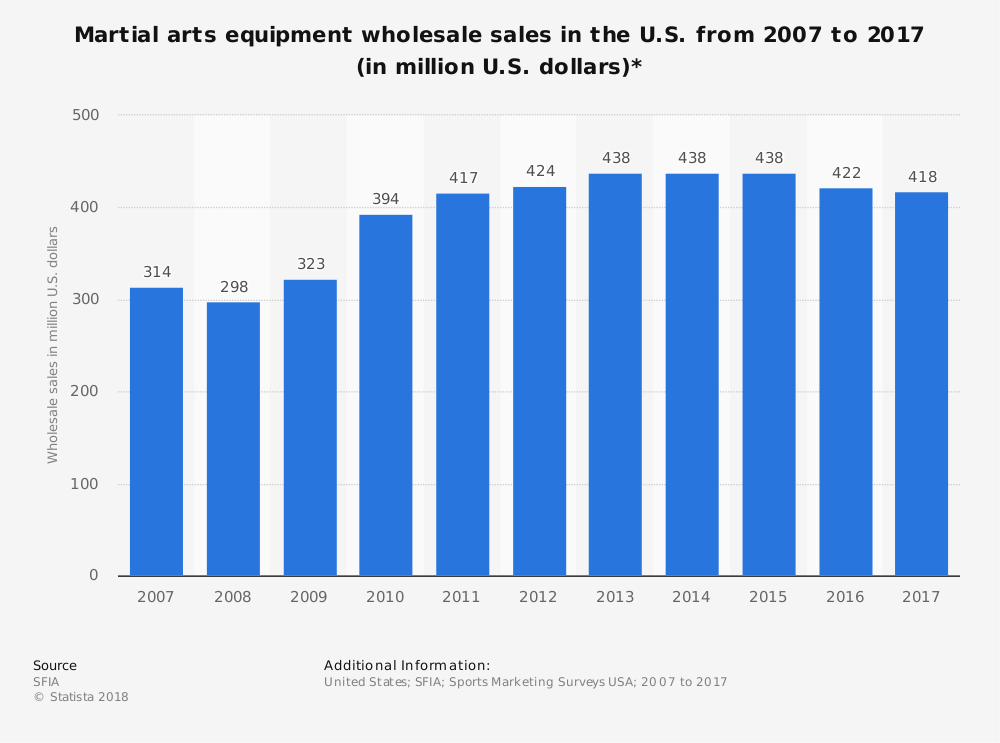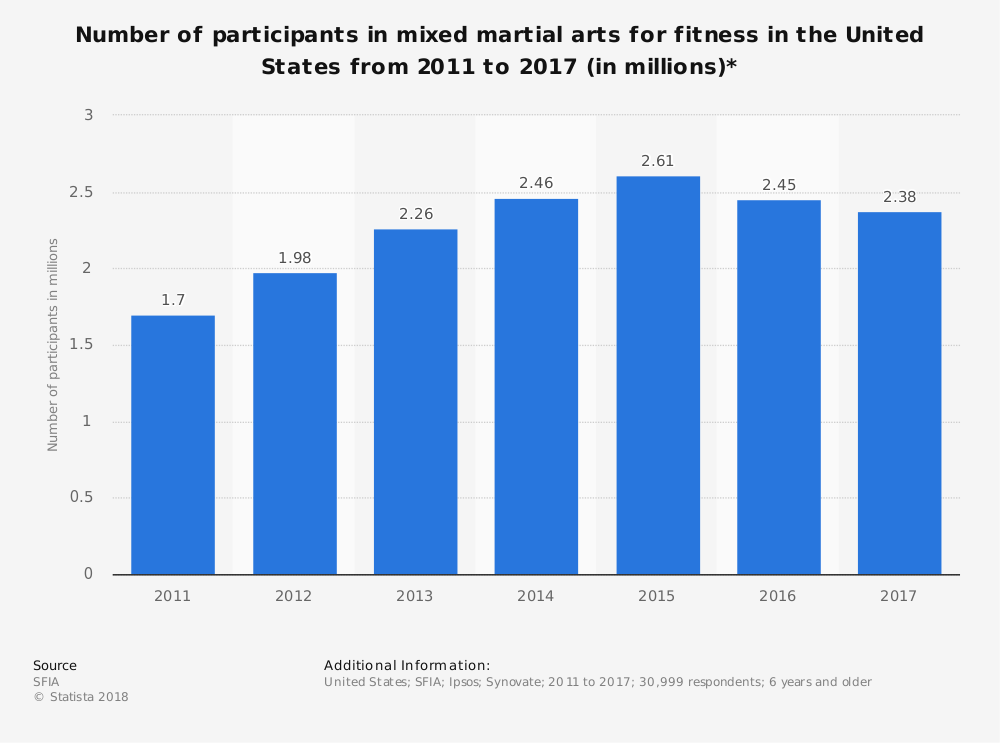Does Asian World of Martial Arts Pay Royalties to Century Martial Arts
The martial arts take a history which dates as far back every bit modern human civilization. As long as humans have been interested in aggression, there has been a need to defend oneself. Rudimentary martial arts were developed to satisfy this need.
Western involvement in the traditions of martial arts adult in the 19th century, as merchandise routes fabricated the world a smaller identify. Media interest in the martial arts began in the 1970s and this exploded the growth of the industry. Movies from Asia and Hollywood began to incorporate martial arts elements into various storylines.
With the development of mixed martial arts (MMA) competitions, the martial arts industry is poised to come across connected interest in the traditions established and so long ago.
Important Marital Arts Industry Statistics
#1. Near three.6 1000000 people actively participate in the martial arts manufacture in the United states each year. Participants under the historic period of 6 are not tracked for statistical purposes. (Statista)
#2. Marital arts studios are able to generate about $iv billion in revenues each year inside the U.S. market. From 2012-2017, the industry was able to attain an annualized charge per unit of growth boilerplate of four.2%. (IBIS World)

#3. Many martial arts studios are owned and operated by a single instructor. There are 75,000 firms operating inside the U.South.-based industry today, employing simply over fourscore,000 people. (IBIS Globe)
#4. In that location are more schools in the United States for martial arts than anywhere in the world. The United States has 16 times more schools than Australia, which comes in second for the global manufacture. (Martial Info)
#5. California (2,181), Florida (1,741), and New York (1,080) all accept more than martial arts studios accepting clients than Australia, with one,035 locations. (Martial Info)
#6. 15% of consumers who work with a martial arts studio do so for personal grooming or small group preparation needs. Just 4% of studios in the United States that are marketed as a fitness location characteristic martial arts training. (Clan of Fettle Studios)
#7. More than 18 meg people in the United states tried karate at least once in the by 12 months. Adults are three times more than probable to attempt karate classes compared to children. (Simmons Market place Enquiry)
#8. 28% of adults in the U.s. say that they participate in martial arts every chance they get to practice so. At the same time, only five% of adults in the U.S. say that they've participated at least once in a class inside the by yr. (Simmons Market Research)
#9. Men (52%) are slightly more than likely than women (48%) to participate in martial arts. Gender statistics include children participating in their preferred martial fine art. (Simmons Market place Inquiry)
#10. 63% of adults that participate in formal martial arts didactics are within the ages of eighteen-34. For the 50+ age demographic, they compose 11% of the adult population engaged in martial arts didactics. (Simmons Market Enquiry)

#11. ane in 4 teens participated in a martial arts course within the past yr. Boys are three percentage points more likely to take tried marital arts than girls in the past 12 months. (Simmons Market Enquiry)
#12. Two out of three teens who participate in the martial arts say that sports are an of import role of their social life. 77% of teens say that their participation in martial arts helps to keep them healthy. Those figures are 10% higher compared to teens who participate in sports other than a martial fine art. (Simmons Market Enquiry)
#13. Access is an effect for martial arts instruction. 28% of children who participate in martial arts come from households earning at to the lowest degree $fifty,000 per year. In comparison, merely x% of children living in households earning less than $fifty,000 per twelvemonth participate in martial arts. (Simmons Market place Research)
#14. xiii% of children nether the historic period of eleven have participated in a martial arts activity within the past year. The gender divergence in young children is much college than it is for the industry equally a whole. 61% of children under xi who participate in martial arts are boys. (Simmons Market Research)
#15. 35% of people who are interested in the martial arts industry take mixed martial arts classes. This is followed by karate (22.2%), taekwondo (12.8%), and judo (x.ii%). (IBIS World)
#16. 73% of people who do martial arts or attend classes at a studio do so for physical fitness. That ranks martial arts as the third-most likely concrete activeness for children in the 6-12 age demographic to participate in this year. (IBIS World)
#17. Virtually martial arts studios are independently endemic and operated. Over 90% of the studios take annual revenues less than ane% each year. (IBIS World)
#eighteen. The largest martial arts studio franchise in the The states is Tiger-Rock Martial Arts. In 2015, the company had 158 franchisees operating throughout the The states. Fifty-fifty with their status as the largest franchise, their total market share for the industry every bit a whole in the U.S. is only ane.8%. (IBIS World)
#19. Although at that place are about thirty,000 facilities which offer at least one martial arts program in the United States, just eight,500 studios are specifically for martial arts. (IBIS World)
Marital Arts Manufacture Trends and Analysis
The benefits of martial arts are many. It provides participants with improved mobility. It improves core strength and ability. Many participants report improved flexibility, stability, and coordination. It provides stress relief and even lowers claret pressure level levels.
As an manufacture, martial arts studios do take some challenges ahead which must exist addressed. Many people like the thought of participating in martial arts. Actual attendance rates are nowhere near the percentage of people who say they're interested in this industry. Just i out of every v people who express interest in martial arts will actually pursue that involvement to a studio to attend at least i form.
With the increment of mixed martial arts competition and various other outlets of exposure for the traditions of this industry, demand levels will likely increment in the coming years. There will also be higher demand levels for martial arts equipment to employ at dwelling.
Different communities may encounter varied results because of unique geographical demands placed on the industry. Equally a whole, even so, the manufacture looks to be on a salubrious pace of growth that shows no signs of stopping.
Source: https://brandongaille.com/19-martial-arts-industry-statistics-trends-analysis/